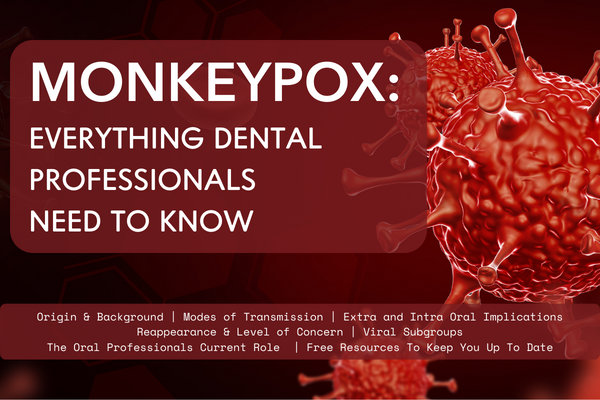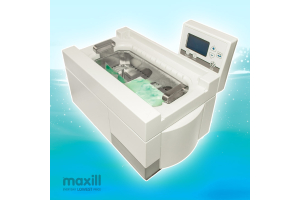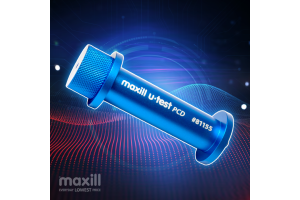Monkeypox Virus Elimination: maxill Has You Covered!

Identifying pathogens to ensure proper elimination has always been part of the infection prevention and control in dentistry. The SARS CoV-2 pandemic has shown how an emerging pathogen can surface and spread globally. Emerging pathogens are defined as a new microorganism or an existing microorganism that is changing patterns. In the hopeful forward movement out of the SARS CoV-2 pandemic, the Monkeypox virus has made a come back from the late 1970’s where in the 1980’s it was believed to be irradicated with successful vaccinations 1. Monkeypox virus is a member of the Orthopoxvirus genus, and includes variola virus (smallpox virus), vaccinia virus, cowpox, and other poxviruses 2. The National Library of Medicine states “the last endemic case of smallpox occurred in 1977, total eradication was confirmed in 1980” 3. “Smallpox helped to shape history, and it made history by being the first disease to be controlled by immunization and the first to be eradicated”3. However, here we are in 2022, discussing Monkeypox and needing to define its characteristics as a virus for transmission and elimination and its extra and intra oral clinical presentations.
Origin & Background
The Monkeypox virus is zoonotic. The Ontario Ministry of Health defines zoonotic exposure as the following:
“A relevant zoonotic exposure may include contact with a dead or live wild animal or exotic pet that is an African endemic species, or use of a product derived from such animals (e.g., game meat, creams, lotions, powders, etc.).” 5.
The NACI states:
“Infection may occur in contexts where there is contact with wild species that are susceptible to monkeypox viruses. Human-to-human transmission of monkeypox virus also occurs amongst close contacts of people infected with monkeypox. Monkeypox is endemic in Central and West Africa, but there have been cases and outbreaks in non-endemic countries due to international travel or the importation of infected animals from affected areas. There are two distinct clades of monkeypox virus: the Congo Basin (Central African) clade and the West African clade. The Congo Basin clade has caused more severe illness” 2.
Modes of Transmission
Microbes are either transmitted by horizontal or vertical modes with direct or indirect contact. “Monkeypox virus is typically transmitted person to person through direct or indirect contact with a person who has symptoms of monkeypox. Sources of infectious materials include body fluids (including respiratory droplets, and the fluid, pus, or blood of skin lesions), rashes, scabs, and fomites (bed linens). Transmission can occur via broken skin (even if skin appears visibly intact), the respiratory tract, or via the mucous membranes of the eyes, nose, or mouth.” 2,4.
The NACI states:
“Based on historical data, monkeypox has a typical incubation period of 6-13 days from exposure but can range from 5-21 days. The disease is usually self-limiting and resolves within 14 to 28 days. Symptoms include fever, headache, back pain, myalgia, asthenia, lymphadenopathy, and skin lesions/rash which typically tend to be more concentrated on the face, extremities, and oral mucous membranes, but can also appear in the genital area. Rash lesions begin as macules and further develop to papules, vesicles, pustules, and then form crusts. The duration of communicability for monkeypox virus may be up to 2-4 weeks, based on limited evidence of PCR detection of monkeypox in the upper respiratory tract. Potential complications of monkeypox include secondary bacterial infections, pneumonia, sepsis, encephalitis, and vision loss from corneal inflammation. Monkeypox virus may cause severe disease in young children, individuals who are immunocompromised, and those who are pregnant. Information about monkeypox in people who are pregnant is sparse, but cases of first trimester miscarriage and stillbirths have been reported” 2.
Public Health Ontario states “Transmission from mother to infant may occur via vertical transmission across the placenta (which can lead to congenital monkeypox) or during close contact during or after birth” 6.
Extra and Intra Oral Implications
Specific to dental professionals, the current Monkeypox virus has oral implications appearing as an extra/ intra oral rash and/or intraoral lesions. The rash can affect the mucous membranes of the mouth and tongue(2). The rash can also affect the palms of hands and soles of the feet (2). The NACI offers the following information regarding the 2022 atypical presentations:
In the current 2022 multi-country outbreak, monkeypox cases may have an atypical presentation including oral, genital, and/or anal lesions with or without fever, or systemic symptoms. Person-to-person transmission can occur through direct contact with a person who is infected. The 2022 multi-country monkeypox outbreak represents the first incidence of broader community transmission in a number of countries outside of certain regions of Africa” 2.
Public health authorities are stating for “Anyone who comes in close contact with people suspected or confirmed to have monkeypox should self-monitor for symptoms for 21 days after exposure. At the onset of symptoms, self-isolate, seek care, and get tested.” 2.
To the dental office this translates to being aware of the extra and intra oral presentations where the person may not have the other accompanying symptoms. This also places the dental professional in a leading IPAC role in following exactly what dental offices have been doing for the last three years with the pandemic: routine and additional precautions as well as Spaulding’s Classification for reprocessing (disinfecting and sterilizing).
Reappearance & Level of Concern
How did the Monkeypox virus reappear? The increase in reported incidence of the Monkeypox virus may be potentially attributable to the following:
- Decreasing herd immunity in the population post termination of vaccination program 4
- Mutations in the virus itself 4
- Changes in the ecosystem that may have caused the natural reservoir’s population density to rise 4
- Increases in frequency of human-wildlife interactions 4
All viruses have the potential to mutate over time and re-surface. Not all ‘come backs’ or mutations are a threat. Variants of concern (VOC) are closely monitored by WHO, CDC and Public Health. VOC are an issue if they impact the health of the public by:
- Spreading at a quicker rate
- Causing an increase in level of illness(s)
- Requiring alternative treatments to what once worked
- Responding poorly or not at all to the current vaccine(s)
At this moment Monkeypox is being observed to ensure it is does not fall into the VOC category. Some local public health units are offering vaccination clinics for any high-risk populations. The National Advisory Committee on Immunization (NACI) works in conjunction with the Public Health Agency of Canada (PHAC) in advising on vaccination programs, including Monkeypox immunizations 2.
Viral Subgroups
Monkeypox virus is an enveloped virus. What does that mean? This is best answered by differentiating between the viral subgroups of enveloped and non-enveloped. The following is a very basic table outlining some characteristics of the viral subgroups:
| Enveloped | Non-enveloped |
| Phospholipid membrane outside the capsid |
No phospholipid membrane outside the capsid (encased in a protein capsid) |
|
Vulnerable to changes in temperature, pH, and chemicals, as such:
|
Resistant to changes in temperature, pH, and chemicals, as such:
|
Does the size of the virus matter? According to the USA Environmental Protection Agency’s the Emerging Viral Pathogen guidance, divides viruses into three categories including size:
- Tier 1: Enveloped viruses are the easiest to inactivate. When disinfectants damage their lipid envelope, the virus is no longer infectious 7
- Tier 2: Large, nonenveloped viruses are encased in protein capsids that make them more difficult to inactivate compared to enveloped viruses 7
- Tier 3: Small, nonenveloped viruses are the hardest to inactivate. Both their protein capsids and their small size make them less vulnerable to disinfectants compared to other viruses 7
The Monkeypox virus and SARS CoV-2 and the SARS CoV-2 variants, fall into a Tier 1 7.
Why is this important to review? This ties into a discussion of selecting an appropriate disinfecting product for all non-porous hard surfaces. Dental offices need to utilize an intermediate disinfectant with broad spectrum claims. Health Canada defines broad spectrum virucide as the following:
"A disinfectant represented as having efficacy against a representative hard to kill non-enveloped virus, and which is expected to inactivate other non-enveloped and enveloped viruses (i.e., the product has demonstrated "broad-spectrum virucidal" efficacy)” 8.
Disinfectant ‘recipe testing’ requires a chosen benchmark organism to ‘test against’. The benchmark organism is strategically selected to be extremely difficult to eliminate (non-enveloped virus). The concept is simple, every microorganism that is easier to eliminate then the benchmark or falls into the same viral category, will be destroyed when following the appropriate contact time(s) and MIFU. If the disinfectant has claims for the same viral category/subgroup (enveloped virus) and/or a more difficult to destroy microorganism (non-enveloped virus), then theoretically the virus is eliminated by the disinfectant’s intermediate broad-spectrum virucidal claims.
What is YOUR Current Role?
To date public health agencies are working in collaboration to investigate cases of Monkeypox. As of June 25, 2022 the WHO has not issued a statement of concern. Dental professionals are being asked to continue to be diligent with IPAC in both routine and additional precautions with the same protocols for SARS CoV-2:
- performing a risk assessment to triage the proper PPE
- stringent hand hygiene protocols
- air quality mitigation measures
- increase of environmental cleaning
- administrative controls
- asepsis control ensuring the use of a disinfectant with broad spectrum virucidal claims against enveloped viruses (adenovirus type 5, bovine parvovirus, canine parvovirus, poliovirus type 1).
- Etc
When disinfecting against the Monkeypox virus using the guidance for disinfecting against emerging viral pathogens, maxill has dental offices covered with the following list of disinfectants that may be used against the Monkeypox virus in accordance with the directions for use against specified organism on hard non-porous surfaces:
In Canada
- tb Minuteman NEX GEN Disinfectant – Adenovirus type 5 [3 minutes]
- tb Minuteman NEX GEN Disinfectant Wipes – Poliovirus type 1 [3 minutes]
- tb Minuteman Hard Surface Disinfectant – Poliovirus type 1 [1 minute]
- tb Minuteman Hard Surface Disinfectant Towelettes – Poliovirus type 1 [1 minute]
- hx2 Hard Surface Disinfectant Spray – Poliovirus type 1 [10 minutes]
In the USA
- mycolio Disinfectant – Adenovirus type 5 [3 minutes]
- mycolio Disinfectant Wipes – Poliovirus type 1 [3 minutes]
Conclusion
Dental professionals are to continue in their professional responsibilities of remaining current on the Monkeypox virus situation with close monitoring of information from public health and dental regulatory bodies. The current Ontario provincial case definition for monkeypox can be found in Appendix 1 of the Infectious Disease Protocol for Smallpox and other Orthopoxviruses including Monkeypox. For further information regarding the monkeypox virus, including signs, symptoms, and how to reduce the risk of infection, visit the Ontario Ministry of Health’s Monkeypox Virus webpage and Public Health Ontario’s Monkeypox webpage. From disinfection of hard surfaces, sterilization of instruments, selection of PPE and hand hygiene practices maxill is here to support dental offices with quality resources and products to keep YOU and your CLIENT safe as the Monkeypox virus resurfaces.
Sources:
- WHO: Monkeypox Fact Sheet "https://www.who.int/news-room/fact-sheets"
- Government of Canada. NACI Rapid Response: Interim guidance on the use of Imvamune in the context of monkeypox outbreaks in Canada. "https://www.canada.ca/en/public-health/services/immunization/national-advisory-committee-on-immunization-naci/guidance-imvamune-monkeypox.html"
- National Library of Medicine. Baxby D. Poxviruses. In: Baron S, editor. Medical Microbiology. 4th edition. Galveston (TX): University of Texas Medical Branch at Galveston; 1996. Chapter 69. Available from: "https://www.ncbi.nlm.nih.gov/books/NBK8364/. "
- European Centre for Disease Prevention and Control (ECDC). Factsheet for health professionals on Monkeypox. June 14, 2022. "https://www.ecdc.europa.eu/en/all-topics-z/monkeypox/factsheet-health-professionals#:~:text=Monkeypox%20virus%20is%20an%20enveloped,%2Drelated%20poxviruses%20%5B2%5D."
- Ontario Ministry of Health. Ontario Public Health Standards: Requirements for Programs, Services and Accountability Infectious Disease Protocol Appendix 1: Case Definitions and Disease Specific Information Disease: Smallpox and other Orthopoxviruses including Monkeypox Effective: June 2022. "https://www.health.gov.on.ca/en/pro/programs/publichealth/oph_standards/docs/smallpox_chapter.pdf"
- PHO. Infection Prevention and Control (IPAC) Recommendations for Monkeypox in Health Care Settings (May 2022). "https://www.publichealthontario.ca/-/media/Documents/M/2020/monkeypox-ipac-recommendations-healthcare-settings.pdf?sc_lang=en"
- USA Environmental Protection Agency. Disinfectants for Emerging Viral Pathogens (EVPs): List Q. "https://www.epa.gov/pesticide-registration/disinfectants-emerging-viral-pathogens-evps-list-q"
- Health Canada. Guidance Document: Safety and Efficacy requirements for hard surface disinfectant drugs. "https://www.canada.ca/en/health-canada/services/drugs-health-products/drug-products/applications-submissions/guidance-documents/disinfectants/safety-efficacy-requirements-hard-surface-disinfectant-drugs.html#a213"
Resources
- Health Canada. https://www.canada.ca/en/public-health/services/diseases/monkeypox/health-professionals/interim-guidance-infection-prevention-control-healthcare-settings.html
- City of Toronto (2022) https://www.toronto.ca/news/toronto-public-health-confirms-first-case-of-monkeypox/
- PHO. Monkeypox. Test Information (May 2022). https://www.publichealthontario.ca/en/Laboratory-Services/Test-Information-Index/Monkeypox-Virus
- PHO. Monkeypox Virus: Interim Case and Contact Management Guidance for Local Public Health Units (May 2022). https://www.publichealthontario.ca/-/media/Documents/M/2022/monkeypox-virus-interim-case-contact-management-guidance-phu







